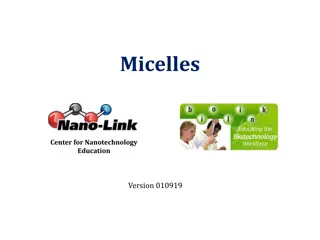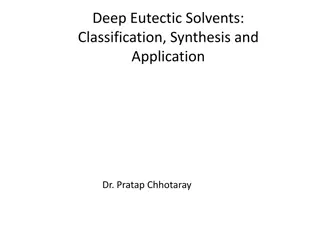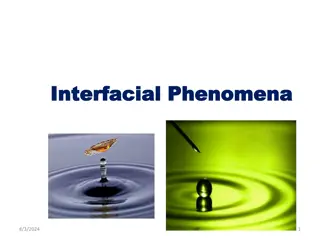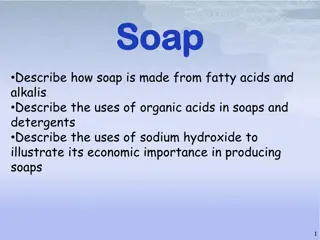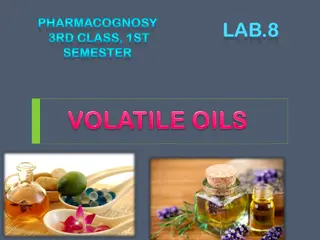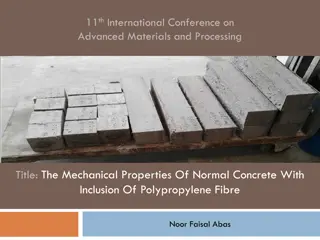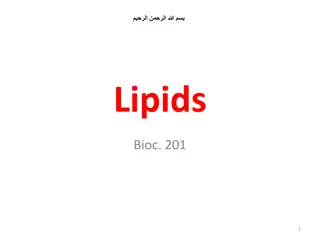Understanding Cosmetic Dosage Forms in the Beauty Industry
Solutions, emulsions, and water-in-silicon formulations are essential cosmetic dosage forms with unique characteristics and applications. Solutions range from water-based to anhydrous, while emulsions offer versatility for delivering hydrophilic and hydrophobic ingredients. Water-in-silicon emulsion
2 views • 19 slides
Cell Communication and Signalling in Biology
Cells communicate through extracellular signalling molecules that bind to specific receptors on target cells, leading to changes in cellular behavior. Hormones such as steroid and peptide hormones, neurotransmitters like nor-adrenaline and acetylcholine, play crucial roles in cell signaling. Recepto
0 views • 25 slides
Understanding Micelles: Key Concepts and Applications
This comprehensive guide delves into the world of micelles, covering topics such as hydrophilic versus hydrophobic substances, the formation and structure of micelles, how detergents work, their role in biological systems, and their applications in drug delivery and other aspects of biology. Learn a
0 views • 26 slides
Deep Eutectic Solvents: Classification, Synthesis, and Applications
Deep Eutectic Solvents (DES) are versatile solvents formed by mixing specific acids and bases. These solvents exhibit unique hydrogen bonding properties, resulting in a lower melting point compared to individual components. DES can be classified into hydrophobic and hydrophilic types, each with dist
3 views • 7 slides
Understanding Interfacial Phenomena in Surfactant Solutions
Micelle formation is a key process in surfactant solutions, where the critical micelle concentration (CMC) is reached leading to the formation of micelles. The CMC decreases with longer hydrophobic chains and is influenced by the addition of electrolytes. Adsorption at solid interfaces and wetting p
1 views • 21 slides
Understanding the Structure and Role of Amino Acids in Proteins
Amino acids are building blocks of proteins, with distinct structures and properties. There are 20 common amino acids found in mammalian proteins, each with a carboxyl group, an amino group, and a unique side chain. The side chains determine the role of an amino acid in a protein, classified as nonp
8 views • 11 slides
Understanding Personal Exposure to Polybrominated Diphenyl Ethers (PBDEs)
This presentation explores the exposure of individuals to PBDEs in residential indoor air, highlighting the background, commercial uses, exposure pathways, and previous studies on PBDEs. It discusses the objectives, methods, results, and conclusions of a study aiming to quantify indoor air exposure
0 views • 22 slides
Understanding Cell Membrane Structure and Proteins
Exploring the basic structure of membranes, the distribution of proteins within the membrane, intrinsic vs. extrinsic proteins, the fluid mosaic model, phospholipids forming the bilayer, the role of hydrophilic and hydrophobic parts in phospholipids, polysaccharides, and the differences between glyc
0 views • 18 slides
Understanding Soap Making and Uses of Sodium Hydroxide
Soap, an ancient detergent made from fatty acids and alkalis like sodium hydroxide, has been utilized for over 3000 years. Fats and oils are essential raw materials for soap production, and organic acids play a role in creating esters. Sodium hydroxide, a key component in soap making, showcases its
0 views • 9 slides
Understanding Lipids: Types, Properties, and Importance
Lipids, introduced by German biochemist Bloor in 1943, are essential components with high energy value. They include fats, oils, waxes, steroids, and more, with unique chemical properties making them hydrophobic. Lipids are organic compounds containing carbon and vary in structure, affecting their p
0 views • 22 slides
Understanding Volatile Oils in Pharmacognosy: Properties, Uses, and Applications
Volatile oils, also known as essential oils, are hydrophobic liquids extracted from plants containing volatile chemical compounds. These oils have diverse physical and chemical properties, making them valuable in various fields like aromatherapy, perfumery, and therapeutics. Learn about the differen
0 views • 12 slides
Mechanical Properties of Concrete with Polypropylene Fibre Inclusion
Concrete is a brittle material that is strong in compression but weak in tension. In this study, the focus is on enhancing the mechanical properties of normal concrete by including polypropylene fibers. The inclusion of fibers helps improve crack resistance and flexural strength, acting as crack arr
0 views • 17 slides
Understanding Complex Lipids: Glycerophospholipids and Sphingolipids
Complex lipids play crucial roles in cellular structure and function. Glycerophospholipids, such as phosphatidylcholine, are amphipathic molecules with hydrophobic fatty acid chains and hydrophilic head groups. They are key components of cell membranes. Sphingolipids, including sphingomyelin and cer
2 views • 95 slides


